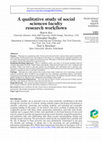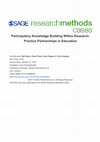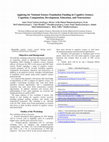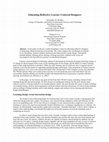Papers by Christopher Hoadley

Journal of Documentation, 2022
Purpose-This paper is a qualitative study of how social sciences faculty construct their research... more Purpose-This paper is a qualitative study of how social sciences faculty construct their research workflows with the help of technological tools. The purpose of this study is to examine faculty scholarly workflows and how both tools and practices support the research process. This paper could inform academic libraries on how to support scholars throughout the research process. Design/methodology/approach-This is a qualitative study case study of ten faculty members from six research universities from the United States and Canada. Semi-structured interviews were conducted and recorded. Atlas.ti was used to code and analyze the transcripts; each participant was a separate case. Descriptive coding was used to identify digital tools used for collaboration; process and descriptive coding was utilized to examine practices in scholarly workflows. Findings-Through case study analysis the results of this study include the role of technology in faculty research workflows. Each workflow was grouped into four categories: information literacy, information management, knowledge management, and scholarly communication. The findings included scholars creating simple workflows for efficiency and collaboration and utilizing workarounds. Research limitations/implications-The study did not observe faculty in the process of doing research and, thus, only reports on what the researchers say that they do. Originality/value-The research is unique in that there is almost no research on how social scientists conduct their research workflows and the affordances/impasses of this process.
For educators to become effective brokers in ways that support equity goals, it is important to c... more For educators to become effective brokers in ways that support equity goals, it is important to consider how brokering is a bi-directional, co-learning practice for both youth and educators. This brief discusses how brokering relationships might support this equity-oriented goal.Spencer Foundation; New York Community Trust; Capital On
It’s important for informal learning organizations that engage in internship placements to consid... more It’s important for informal learning organizations that engage in internship placements to consider how these early work settings are identified and vetted so that underrepresented youth are more likely to have positive experiences. This brief offers some strategies and a framework to support the process.Spencer Foundation; New York Community Trust; Capital On
Brokers can play crucial roles in identifying, making visible, and breaking down power structures... more Brokers can play crucial roles in identifying, making visible, and breaking down power structures for youth. In this brief, we discuss how brokers may directly contribute to breaking down or sustaining power inequalities in access and opportunity.Spencer Foundation; New York Community Trust; Capital On
This brief addresses some questions about how we might support informal educators to develop a “b... more This brief addresses some questions about how we might support informal educators to develop a “brokering orientation” and see themselves as learning brokers who actively connect youth to new opportunities, people, and institutions.Spencer Foundation; New York Community Trust; Capital One Foundatio
What is brokering, and why is it an important practice when it comes to supporting learning pathw... more What is brokering, and why is it an important practice when it comes to supporting learning pathways? This brief introduces the idea of brokering as a practice supporting connections to learning opportunities, offers a conceptual model of factors affecting brokering, and gives an overview of potential strategies for integrating brokering into out-of-school programming.Spencer Foundation; New York Community Trust; Capital On
When OST organizations bring projects into the classroom, they have an opportunity to act as lear... more When OST organizations bring projects into the classroom, they have an opportunity to act as learning brokers that can support the futures of a great number of young people. This brief discusses some key strategies to consider.Spencer Foundation; New York Community Trust; Capital On

This case study considers how educational researchers and practitioners can work together to enga... more This case study considers how educational researchers and practitioners can work together to engage in participatory knowledge building, a process rooted in both empirical research and the lived practices and expertise of on-the-ground educators that produces knowledge relevant to both educational theory and practice. The method shared was used as part of a broader approach called research-practice partnerships (RPPs), a model of collaboration between researchers and practitioners that departs from and counters traditional assumptions of "research translation" that suppose a unidirectional relationship where researchers simply share findings with educators, administrators, and youth. Instead, research-practice partnerships are characterized by joint work, mutuality, and a focus on persistent problems of practice across stakeholder groups. Within research-practice partnerships, we propose participatory knowledge building as one method that indexes these values. Rooting our case in the production of collaborative white papers addressing shared issues between researchers and practitioners, we first focus on practical techniques associated with participatory knowledge building, then discuss the outcomes of this approach for researchpractice partnerships, and finally make recommendations for utilizing this approach. In discussing techniques to develop collective knowledge through participatory processes, we detail topic emergence and selection, leveraging community contexts as spaces for knowledge building, integrating basic research data, synthesizing and creating an initial draft of the paper, and engaging in community-based feedback and dissemination. We then detail the outcomes that such a process has for those engaged in research-practice partnerships, including development of shared language, fostering a collective knowledge-building orientation, surfacing practitioner expertise, implicit renegotiation of the focus of joint work, and catalyzing new educational experiments and shifts in practice. We close with lessons learned from our experience in this area and recommendations for others who are looking to engage in this practice. Broadly, the case highlights both the practicalities and affordances of using collaborative, participatory methods of knowledge production when the goal is first and foremost to improve educational practice. Learning Outcomes By the end of this case, students should be able to Understand what techniques can be used in order to produce knowledge collaboratively between educational researchers and practitioners Understand the possible outcomes of participatory knowledge building between educational SAGE Research Methods Cases Part 2 SAGE

Cognitive Science, 2014
Applying for National Science Foundation Funding in Cognitive Science: Cognition, Computation, De... more Applying for National Science Foundation Funding in Cognitive Science: Cognition, Computation, Development, Education, and Neuroscience Anne Cleary 1 (acleary@nsf.gov), James Donlon 2 (jdonlon@nsf.gov), Evan Heit 3* (ekheit@nsf.gov), Chris Hoadley 2,3 (choadley@nsf.gov), Laura Namy 1 (lnamy@nsf.gov), Akaysha Tang 1 (atang@nsf.gov), Betty Tuller 1 (btuller@nsf.gov) Division of Behavioral and Cognitive Sciences, Directorate for Social, Behavioral & Economic Sciences Division of Information and Intelligent Systems, Directorate for Computer & Information Science & Engineering Division of Research on Learning, Directorate for Education & Human Resources National Science Foundation 4201 Wilson Boulevard Arlington, Virginia 22230 USA *Corresponding author Keywords: cognitive science; research funding; grants; workshop; National Science Foundation. those most relevant to cognitive science, as well career development programs and international opportunities. 3. Attendees will participate in ...
Proquest Dissertations and Theses Thesis University of California Berkeley 1999 Publication Number Aai9931263 Isbn 9780599314801 Source Dissertation Abstracts International Volume 60 05 Section a Page 1505 229 P, 1999
Google, Inc. (search), Subscribe (Full Service), Register (Limited Service, Free), Login. Search:... more Google, Inc. (search), Subscribe (Full Service), Register (Limited Service, Free), Login. Search: The ACM Digital Library The Guide. ...

In this paper we discuss a multidisciplinary course for educating reflective designers of technol... more In this paper we discuss a multidisciplinary course for educating reflective designers of technology-enhanced learning environments. The course supports the coordination of students in two disciplines, human-computer interaction and instructional systems design. Through the multidisciplinary teaming and an ontology of design processes, students in the course are encouraged to develop reflective practice as educational designers. Learner-centered design of technology-enhanced educational environments (learning technology design, or LT design for short) requires both a focus on the learning goals for the design, and the ability to connect learning goals to their implementation in interfaces. While the ends, learning, may be relatively clear, it requires special expertise to develop the means for supporting learning through technologies. Early proponents of learner-centered design (Soloway et al.) were cross-trained individuals with a background in both computer science and education. The TRAILS project (http://www.trails-project.org) has as its aim producing more such individuals who can successfully integrate usability and interface design with educational theory and practice to produce effective learning environments (see DiGiano et. al., 2005.) In this paper, we first discuss our goals for the Penn State TRAILS course, including a blend of both learning design and interaction design. We then discuss our pedagogical strategy for this goal, namely using reflective practice of design methods in an interdisciplinary context. We then describe the course in detail, including our teaming strategy, projects and assignments to promote student reflection and practice of various design methods, and an ontology of design methods used to help students compare and contrast various learning and interaction design methodologies.
Lecture Notes in Computer Science, 2016
In the originally published version of the paper starting on page 87 of this volume, the means an... more In the originally published version of the paper starting on page 87 of this volume, the means and the F-values in Table 2 and the M and SD values in the first paragraph of Sect. 5.3 were incorrect. These have been corrected.
Educational Technology the Magazine For Managers of Change in Education, 2004

Lecture Notes in Computer Science, 2016
Research on the use of mobile to promote mindfulness states is still rela‐ tively nascent, especi... more Research on the use of mobile to promote mindfulness states is still rela‐ tively nascent, especially when exploring how such states can be cultivated in everyday life, outside of meditation-based approaches. In this study we investigate the design of a mobile app that seeks to cultivate mindfulness states situated in everyday life. Using reminders to prompt self-reflection and breathing exercises to prompt body awareness, we sought to address the overarching question – how can we design towards mindfulness situated in everyday living and how might it change what we mean by mindfulness? Our findings suggest that mobile-based approaches can promote curiosity and decentering through self-reflection, and that the valence and likelihood of experiencing certain mental events may influence how self-reflection is experienced, which in turn influences curiosity and decentering factors of mind‐ fulness states.
This paper describes the creation of a design studio course for students in an innovative graduat... more This paper describes the creation of a design studio course for students in an innovative graduate degree program in the School of Education at Stanford University. While design studios are common in other fields, they are unusual in education. The rationale for this course is presented, our experiences running the course for four years are summarized, and implications for academic
... Studies in Computer Science project. Christopher Hoadley was also supported by a University o... more ... Studies in Computer Science project. Christopher Hoadley was also supported by a University of California Regents' Fellowship and the Evelyn Lois Corey Fellowship during portions of this work. APPENDIX A: THE APPLICATIVE ...
How can students develop shared criteria especially for problems that have no "right" answer? Suc... more How can students develop shared criteria especially for problems that have no "right" answer? Such ill-structured problems are typically called design problem. They can be identified by their open-endedness, the problem structuring they require, and the iterative refinement that characterizes solution paths.. Like portfolio projects, these problems are difficult to evaluate for both teachers and students. Often success is measured

Uploads
Papers by Christopher Hoadley